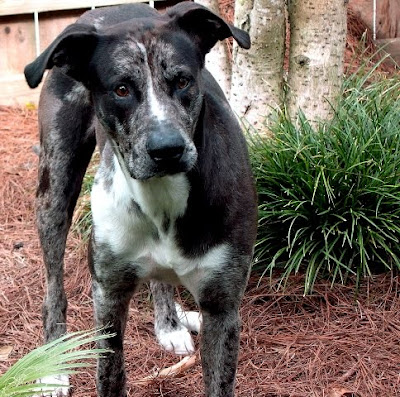Here is Stacy's email to me.
Here is a new pic of our baby girl. She was from the catahoula/cocker spaniel litter. We picked her up from you in early January. She was 4 lbs then, here she is at 4 months and about 18 lbs. She is a very smart baby, VERY active, but such a sweetheart! We love her very much. She did her first blood trail this weekend, she did awesome.
Stacy

If you need a blood trail dog, get it now!
 These guys and girls are bored, need a job, and a good home.
These guys and girls are bored, need a job, and a good home.Just because you show up at my house with money, does not qualify you to own my dogs.
I suggest you call and talk to me a few times to see if one of my dogs fit your service needs.
I do not need to sell these dogs, I spend a lot of time getting them right for you. I need to find the right people for them.
Don't wait until this fall and you have a downed deer you can't find to contact me.
You spend all year planting feed plots, scouting, planning, buying more camo, ATV's, outboard motors, guns, scents, treestands, calls, knives, gloves, hats, videos, etc.
And you don't have a blood trailing dog?
I have a few left from this litter and they were bred for blood trail work.
These puppies are bred to be easy to handle and devoted to what ever you need.
Be it security, companionship, or squirrel hunting, these dogs wait on you hand and foot!
I have several crosses specially for blood trail and quality pet placement.
I have found that crossing with a Cocker Spaniel, Beagle or Chihuahua makes a better pet, or blood dog because they are easier to handle and it takes some of the wild wolf behavior out of them.
These pups will hunt and help you find a dead or wounded deer, but are easy going, and much easier to train and handle, not like my elite,(as seen below)
 high performce, smart, fast, gritty, hog dogs that will not stop at a dead deer and wait for you.
high performce, smart, fast, gritty, hog dogs that will not stop at a dead deer and wait for you.Because a pure bred Catahoula can be a hand full for most people, I recommend you consider getting a cross bred dog for pets or blood trailing.
 Bob, the father of Jesse, Spider, and Whiteboy
Bob, the father of Jesse, Spider, and WhiteboyBeau Jocque, a son of the legendary, Maurice

Sammy, a son of Maurice and Alida






